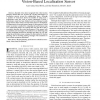Free Online Productivity Tools
i2Speak
i2Symbol
i2OCR
iTex2Img
iWeb2Print
iWeb2Shot
i2Type
iPdf2Split
iPdf2Merge
i2Bopomofo
i2Arabic
i2Style
i2Image
i2PDF
iLatex2Rtf
Sci2ools
ICRA
2000
IEEE
2000
IEEE
Computing the Sensory Uncertainty Field of a Vision-Based Localization Sensor
—Recently it has been recognized that robust motion planners should take into account the varying performance of localization sensors across the configuration space. Although a number of works have shown the benefits of using such a performance map, the work on actual computation of such a performance map has been limited and has addressed mostly range sensors. Since vision is an important sensor for localization, it is important to have performance maps of vision sensors. In this paper we present a method for computing the performance map of a vision-based sensor. We compute the map and show that it accurately describes the actual performance of the sensor, both on synthetic and real images. The method we use (following [10]) involves evaluating closed form formulas and hence is very fast. Using the performance map computed by this method for motion planning and for devising sensing strategies will contribute to more robust navigation algorithms.
| Added | 31 Jul 2010 |
| Updated | 31 Jul 2010 |
| Type | Conference |
| Year | 2000 |
| Where | ICRA |
| Authors | Amit Adam, Ehud Rivlin, Ilan Shimshoni |
Comments (0)

